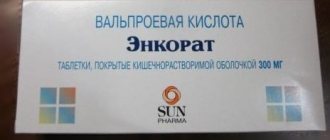Difenin tablet 117 mg x20
Trade name: Diphenin tablets 0.117 g International name: Phenytoin
Release form: tablets 117 mg (dark glass jars, cell-free contour packages, cell contour packages)
Composition: phenytoin 100 mg
Pharmacological group: antiepileptic drug
Pharmacological group according to ATK: N03AB02 (Phenytoin)
Pharmacological action: antiarrhythmic, sedative, antiepileptic,
Indications: Epilepsy, epileptic seizures, supraventricular and especially ventricular cardiac arrhythmias caused by intoxication with cardiac glycosides, prevention of ventricular arrhythmias after cardiac surgery, ventricular arrhythmias during general anesthesia, during cardiac catheterization and coronary angiography, bradyarrhythmia or heart block in case of overdose tricyclic antidepressants, rhythm disturbances associated with organic damage to the central nervous system (especially epilepsy), congenital long QT syndrome (if monotherapy with beta-blockers is ineffective), before electrical restoration of sinus rhythm in patients with atrial fibrillation after digitalization (to prevent the development of rhythm disturbances) , trigeminal neuralgia, episodic behavioral disorders (hyperexcitability, anger, anxiety, irritability, insomnia), paroxysmal choreoathetosis, myotonia (including congenital).
Dosage regimen: Orally, after meals, as an anticonvulsant and sedative drug - 0.1-0.3 g 1-3 times a day. As an antiarrhythmic drug - 0.1 g 4 times a day, the antiarrhythmic effect appears on days 3-5, after which the daily dose is reduced to 0.3 g. To quickly achieve a therapeutic concentration - 0.2 g 5 times on the first day, 0.1 g 5 once every 2-3 days and 0.1 g 2-3 times a day from the 4th day of treatment, in this case the antiarrhythmic effect is achieved by the end of 1-2 days of treatment. In children, the daily oral dose is 2-4 mg/kg. In case of severe liver failure, it is necessary to reduce the daily dose by 50%.
Contraindications: Hypersensitivity, Morgagni-Adams-Stokes syndrome, grade II-III AV block, sinoauricular block and sinus bradycardia, pregnancy, lactation.
Side effects: From the nervous system: tremor, ataxia, dysarthria, diplopia, irritability, insomnia, dizziness. From the senses: nystagmus, pain in the eyes. From the digestive system: gastritis, loss of appetite, nausea, vomiting, gastralgia. From the hematopoietic organs: leukopenia, aplastic anemia, megaloblastic, B12-deficiency anemia, agranulocytosis, lymphadenopathy. Allergic reactions: skin rash, fever, exfoliative dermatitis with hepatitis. Other: polyarthritis, hirsutism, gingival hyperplasia, weight loss, changes in connective tissue (coarsening of facial features, Dupuytren's contractures), teratogenic effects in the form of deformities of the facial part of the skull, skeletal deformities and heart defects, with long-term use (after 2-5 months) — disturbance of calcium-phosphorus metabolism, latent osteopathy.
Pharmacodynamics: An antiepileptic drug without a pronounced hypnotic effect, it has membrane stabilizing, antiarrhythmic and hypotensive effects. The antiepileptic effect is due to the stabilization of the neuronal membranes of the nerve cell body, axons and in the area of the synapse and, as a result, limiting the spread of neuronal excitation and convulsive activity. Blocks “fast” Na+ channels, reduces the entry of Na+ and Ca2+, thereby lengthening the refractory period in the process of generating nerve impulses. Antiarrhythmic properties are due to the effect on transmembrane ion exchange, while the ratio of extracellular Na+ to intracellular and, possibly, transmembrane Ca2+ exchange increases. It prevents the release of K+ from the myocardium under the influence of cardiac glycosides and, to one degree or another, neutralizes the electrophysiological changes caused by them. Without significantly affecting the automaticity of the sinus node and atrial cells in average doses, it reduces the automaticity of the cells of the His-Purkinje system, shortens the duration of the action potential in it due to the repolarization period, reduces the effective refractory period, interrupts the re-entry mechanism, reduces the severity of AV blockade caused by digitalis, does not have a noticeable effect on intraventricular conduction (the width of the QRS complex on the ECG). Increases the threshold of pain sensitivity in trigeminal neuralgia and reduces the duration of the attack.
Pharmacokinetics: Absorption - 50-80%, slow (lower in newborns). Bioavailability - 20-50%. Communication with plasma proteins is 90-95%. TCmax when taken orally varies due to different absorption rates and ranges from 1.5-3 to 15 hours. Cmax is 18 mcg/ml. Penetrates into CSF, saliva, semen, gastric and intestinal juice, bile and breast milk. Passes through the placenta (concentrations in the fetal blood serum are equal to those in the maternal blood serum). Has a “first pass” effect through the liver. Metabolized in the liver with the participation of the CYP2C9 isoenzyme. It is an inducer of the isoenzymes CYP3A4, CYP3A5 and CYP3A7. T1/2 - 24 hours. Excreted by the kidneys - 35-60%, with bile - 40-65%. Excretion increases with alkaline urine.
Special instructions: During treatment, careful selection of doses is necessary (for epilepsy, the concentration in the blood is determined on the 7-10th day of treatment), because elimination is a saturable process, and increasing doses may be accompanied by a disproportionate increase in plasma concentrations. During the treatment period, it is necessary to monitor the concentration of Ca2+ and phosphorus in the blood serum. In case of severe side effects, the dose of the drug is reduced or treatment is stopped. Carefully. Alcoholism, CHF, diabetes mellitus, fever, liver failure, cachexia, porphyria, SLE.
Interaction: Increases hepatotoxicity and prolongs the effect of paracetamol. Increases the toxicity of chlorpromazine and other derivatives of phenothiazine, reserpine, sulfonamides. Amiodarone increases phenytoin blood concentrations. Antacids containing Al3+, Mg2+ and calcium carbonate salts, drugs for parenteral nutrition, sucralfate reduce bioavailability, calcium sulfate reduces absorption by 20%. Indirect anticoagulants, chloramphenicol, cimetidine, disulfiram, antiviral vaccine, isoniazid, methylphenidate, phenylbutazone, ranitidine, salicylates, sulfonamides, fluconazole, ketoconazole, miconazole reduce metabolism, increase active concentrations in the blood and enhance the anticonvulsant effect. Anticonvulsants (succinimide, carbamazepine), estrogen-containing contraceptives, GCS and MCS, ACTH, cyclosporine, dacarbazine, digitalis glycosides, disopyramide, doxycycline, estrogens, furosemide, levodopa, mixeletine, quinidine, methadone, praziquantel, vitamin D, aminophylline, caffeine, oxtriphylline , theophylline is metabolized more intensively (due to the induction of microsomal liver enzymes by phenytoin), resulting in a decrease in their concentration in the blood. Tricyclic antidepressants, bupropion, clozapine, haloperidol, loxapine, maprotiline, molindone, MAO inhibitors, phenothiazines, pimozide, thioxanthenes, sulfinpyrazone reduce the anticonvulsant effect (therefore, dose adjustment of phenytoin may be required). Phenytoin can increase the concentration of glucose in the blood, and therefore reduces the effect of insulin and oral hypoglycemic drugs, reduces the complexation of levothyroxine with plasma proteins by 15-25%. Barbiturates, primidone, fluoxetine, folic acid can change the concentration of phenytoin in the blood (there is a need to monitor its concentration). Diazoxide reduces the hyperglycemic activity of phenytoin. Dopamine can contribute to the development of arrhythmia and lower blood pressure. Influrane, halothane, methoxyflurane - Use of phenytoin before anesthesia may increase the metabolism of the anesthetic and the risk of hepatotoxicity and nephrotoxicity. Lidocaine and beta-blockers in combination with phenytoin can depress cardiac activity, while the metabolism of lidocaine significantly increases. Omeprazole, by inhibiting the cytochrome P450 system, reduces the metabolism of phenytoin. Rifampin stimulates liver metabolism. Phenytoin protects pancreatic beta cells from the toxic effects of streptozocin. Trazodone increases blood concentrations of phenytoin. Valproic acid and phenytoin inhibit each other's metabolism, which may lead to increased hepatotoxicity. Phenobarbital and carbamazepine increase the elimination (mutually) of phenytoin. Drugs of the isoniazid group, ASA, chloramphenicol and disulfiram inhibit metabolism, increasing side effects. When co-administered with other hematotoxic drugs, increased hematotoxicity is possible.
Drug registration number: 74/331/63
Diphenine
During treatment, careful selection of doses is necessary (for epilepsy, the concentration in the blood is determined on the 7-10th day of treatment) since an increase in dose may be accompanied by a disproportionate increase in plasma concentration in the blood.
Most patients maintain stable serum phenytoin concentrations when taking stable doses. However, significant variations in phenytoin serum concentrations may occur in individual patients when equivalent doses are used. A patient with large fluctuations in plasma phenytoin levels despite the use of standard doses presents a challenging clinical problem. Determination of serum levels in such patients is critical. In some cases, the development of an epileptic seizure can be prevented with a serum phenytoin concentration of 6-9 mcg/ml (24-36 μmol/l). Although the relationship between drug concentrations, clinical efficacy and tolerability varies among patients, treatment effectiveness should be assessed by clinical signs of the disease and serum drug concentrations, especially in cases where there is a change in the frequency of attacks, when treating children and adolescents, when the development of toxic symptoms is suspected. reactions and in cases of combined anticonvulsant therapy.
The use of Diphenin in the monotherapy of absence seizures and the prescription of combination therapy in case of joint development of tonic-clonic seizures and absence seizures are not recommended.
Use in patients with porphyria is not recommended, as Difenin can provoke an exacerbation of the disease.
During the treatment period, it is necessary to monitor the content of calcium and phosphorus in the blood serum. With long-term treatment, the development of osteopenia, osteoporosis, osteomalacia is possible due to a decrease in bone mineral density, bone fractures due to the development of hypovitaminosis D, hypocalcemia and hypophosphatemia. The exact mechanism of phenytoin's effect on bone metabolism is unknown; Long-term therapy with phenytoin requires concomitant use of vitamin D supplements.
When using Diphenin in children during the growth period, the risk of developing side effects from connective tissue increases.
When treating with Diphenin, at the beginning of therapy monthly, and subsequently every six months, it is necessary to conduct a clinical blood test, liver enzymes, alkaline phosphatase, and also monitor thyroid function. Patients should be informed of the importance of strictly adhering to the prescribed dosage regimen; sudden discontinuation of the drug is unacceptable and may provoke an epileptic attack.
Diphenine should be immediately discontinued if hypersensitivity reactions or symptoms appear that suggest the possible development of Stevens-Johnson syndrome or Lyell's syndrome. Drug-induced hypersensitivity syndrome (systemic idiosyncrasy reaction) is a rare but potentially dangerous complication of antiepileptic therapy. Clinical manifestations include fever, maculopapular rash, lymphadenopathy, leukocytosis combined with eosinophilia and/or lymphocytosis. Various organ systems can be involved in the pathological process with the development of hepatitis, nephritis, pneumopathy and others. The syndrome has been described when taking phenytoin, carbamazepine, phenobarbital, valproate (extremely rare).
The etiology and pathogenesis of the development of the syndrome are unknown. The development of the syndrome is most often observed in the period from 2 to 4 weeks from the start of phenytoin therapy, with possible development in the period of 3 or more months from the start of therapy. If the syndrome develops, phenytoin should be discontinued and appropriate therapy prescribed. A higher risk of developing the syndrome is observed in patients with decreased immunity and a history of systemic allergic reactions.
Patients with impaired liver function and the elderly require adjustment of the dosage regimen.
In acute alcohol intoxication, the concentration of phenytoin in the blood increases, and in chronic intoxication it decreases. It is necessary to warn the patient about the need to avoid drinking alcohol-containing drinks during treatment with Diphenin.
When treated with Difenin, toxic effects from the central nervous system may develop if the permissible therapeutic concentration of phenytoin in plasma is exceeded: delirium, psychosis, encephalopathy or, in rare cases, cerebellar dysfunction.
In some cases, treatment with antiepileptic drugs, including Diphenin, was accompanied by the occurrence of suicidal thoughts/attempts. This was also confirmed in a meta-analysis of randomized clinical trials. Epilepsy can also trigger suicidal thoughts. Patients and those around them must be warned about the possibility of suicidal thoughts and, if they occur, they must immediately seek medical help.
Phenytoin may decrease serum T4 concentrations. Phenytoin may lead to increases in serum glucose, alkaline phosphatase and gamma glutamyl transpeptidase (GGT).
Difenin affects glucose metabolism and insulin production; hyperglycemia may develop with toxic concentrations of phenytoin in plasma, so it is impossible to use Difenin in the treatment of seizures against the background of hypoglycemia or seizures caused by metabolic disorders.
When treated with antiepileptic drugs, including Difenin, cases of the development of severe exfoliative dermatitis accompanied by fever, eosinophilia and systemic manifestations (DRESS syndrome), with the development of life-threatening conditions and death, have been described.
Drug-induced hypersensitivity syndrome with eosinophilia (DRESS) is characterized as a life-threatening systemic multiorgan reaction manifested by rashes, fever, lymphadenopathy, leukocytosis with eosinophilia, hepatitis, as well as involvement of other organs, with the development of nephritis, hematological disorders, myocarditis, myositis, etc. . When the first signs appear, it is necessary to immediately conduct a full examination of the patient and stop treatment with Diphenin.
There have been cases of acute hepatotoxicity with the use of phenytoin, manifestations of which may include jaundice, hepatomegaly, high levels of transaminases, leukocytosis and eosinophilia. This can be either one of the manifestations of DRESS syndrome or an isolated syndrome. In such patients, it is necessary to immediately stop therapy with Diphenin.
When using Difenin, changes in the hematopoietic system may occur, including thrombocytopenia, leukopenia, granulocytopenia, agranulocytosis and pancytopenia, sometimes with fatal outcomes. Cases of lymphadenopathy, benign lymph node hyperplasia, pseudolymphomas and Hodgkin's disease have been reported. It is necessary to carefully monitor patients if these reactions develop during phenytoin therapy, and timely correction of therapy. Macrocytosis and megaloblastic anemia are successfully treated with folic acid. If the lymph nodes are affected, fever, rash, and liver damage may occur, but these symptoms may not be present. For any lymphadenopathy, a long period of monitoring the patient's condition is required, with consideration of the possibility of using antiepileptic drugs of other groups.


